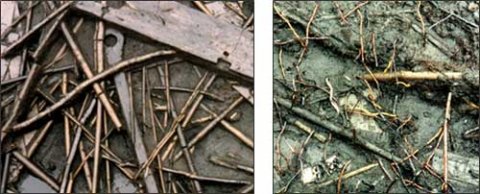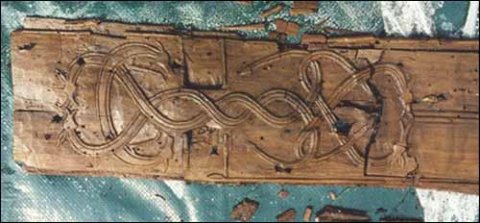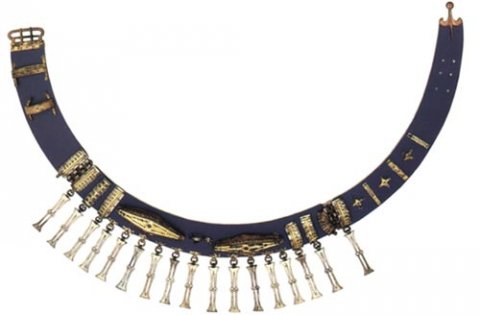In the early 1990’s Piet van Deurs and the Danish television station DR1 produced a documentary series where the excavation team was observed on a weekly basis. It was a very absorbing programme with a following of many viewers throughout Denmark, and Nydam Bog achieved instant nationwide fame.

The wooden parts of both ships and weapons lay intertwined, bound together and penetrated by a network of horsetail (Equisetum spp.) roots.

The filigree ornamentation on the sheath is carved from silver sheet and decorated with inlay of niello (a black composition of sulphur with silver, lead or copper used for filling engraved lines in silver or other metals). The carved animal heads and impressed decoration of the ornaments are typical for the so-called Sösdala-style, named after sacrificial finds in Skåne.

The sword sheath below was photographed prior to preservation. It is very artistically carved with interlaced ribbons and animal heads. The wooden surface has been reinforced by a cover of thin hide (vellum), through which the relief is clearly visible.

The photographs below show three unique discoveries. On the left, a sword ornament of transparent quartz in a silver mounting. The bead sat in a cord bound to and wound around the hilt of the sword, to indicate peaceful intentions. (The sword was sheathed).
The springing lion is made of gilded silver. Five small rivet holes suggest that the lion was fastened to a wooden article, possibly a shield.
The right-hand picture shows a bronze fibula (large clasp) of a hitherto unknown type, found in 1996. The fibula has a similar form to that of a Roman officer’s fibula – a so-called onion-shoot fibula – but must have been crafted by a northern European metalworker.

Scandinavia’s most complete officer’s belt is shown below. The beautiful decorative belt displays 27 metal ornaments in bronze, silver and gold.